Genetics Final Exam Cumulative
1/155
There's no tags or description
Looks like no tags are added yet.
Name | Mastery | Learn | Test | Matching | Spaced |
|---|
No study sessions yet.
156 Terms
Gene
The basic(physical) unit of heredity passed from parent to child. Genes are made up of sequences of DNA and are arranged, one after another, at specific locations on chromosomes in the nucleus of cells.
Genetics
The branch of biology concerned with the study of inheritance, including the interplay of genes, DNA variation and their interactions with environmental factors.
DNA
Deoxyribonucleic, the molecule that carries genetic information for the development and functioning of an organism. DNA is made of two linked strands that wind around each other to resemble a twisted ladder — a shape known as a double helix.
Chromosome
Structures in the cell nucleus that are composed of chromatin and contain the genes. The chromosomes become visible under the microscope as distinct structures during cell division.
Allele
one of two or more versions of DNA sequence (a single base or a segment of bases) at a given genomic location. An individual inherits two alleles, one from each parent, for any given genomic location where such variation exists. If the two alleles are the same, the individual is homozygous for that allele.
Phenotype
The set of observable characteristics of an individual resulting from the interaction of its genotype with the environment.
Genotype
The genetic makeup of an organism; in other words, it describes an organism's complete set of genes. In a more narrow sense, the term can be used to refer to the alleles, or variant forms of a gene, that are carried by an organism.
Heredity
The passing on of physical or mental characteristics genetically from one generation to another.
Genome
Originally, all the genetic material in a cell or individual organism. The term is used more than one way, depending on context: e.g., an organism's haploid genome is all the DNA contained in one haploid set of its chromosomes, and its mitochondrial genome is all the DNA in a mitochondrion. See human genome.
Discovery-based science
No preconceived specific hypothesis
aims to observe, explore, and discover
Pro: Less confirmation bias; Con: May yield little useful data or questions
Hypothesis-based science
begins with a specific question or problem and a potential answer or solution that can be tested
(scientific method)
Pro: answer a defined question
Con: Confirmation bias
Name four processes that can be responsible for evolutionary change in populations of a species.
>Natural selection
>Migration
>Mutation
>Genetic drift
Define the terms genotype and phenotype
phenotype
The set of observable characteristics of an individual resulting from the interaction of its genotype with the environment.
Genotype:
The genetic makeup of an organism; in other words, it describes an organism's complete set of genes. In a more narrow sense, the term can be used to refer to the alleles, or variant forms of a gene, that are carried by an organism.
What does ‘PCR’ stand for, and when was it invented?
(Mullis, 1985)
Polymerase Chain Reaction
In an experiment, what is an independent variable? What is a dependent variable?
Independent variable – experimental treatments, or observed categories
Dependent variable – what was measured
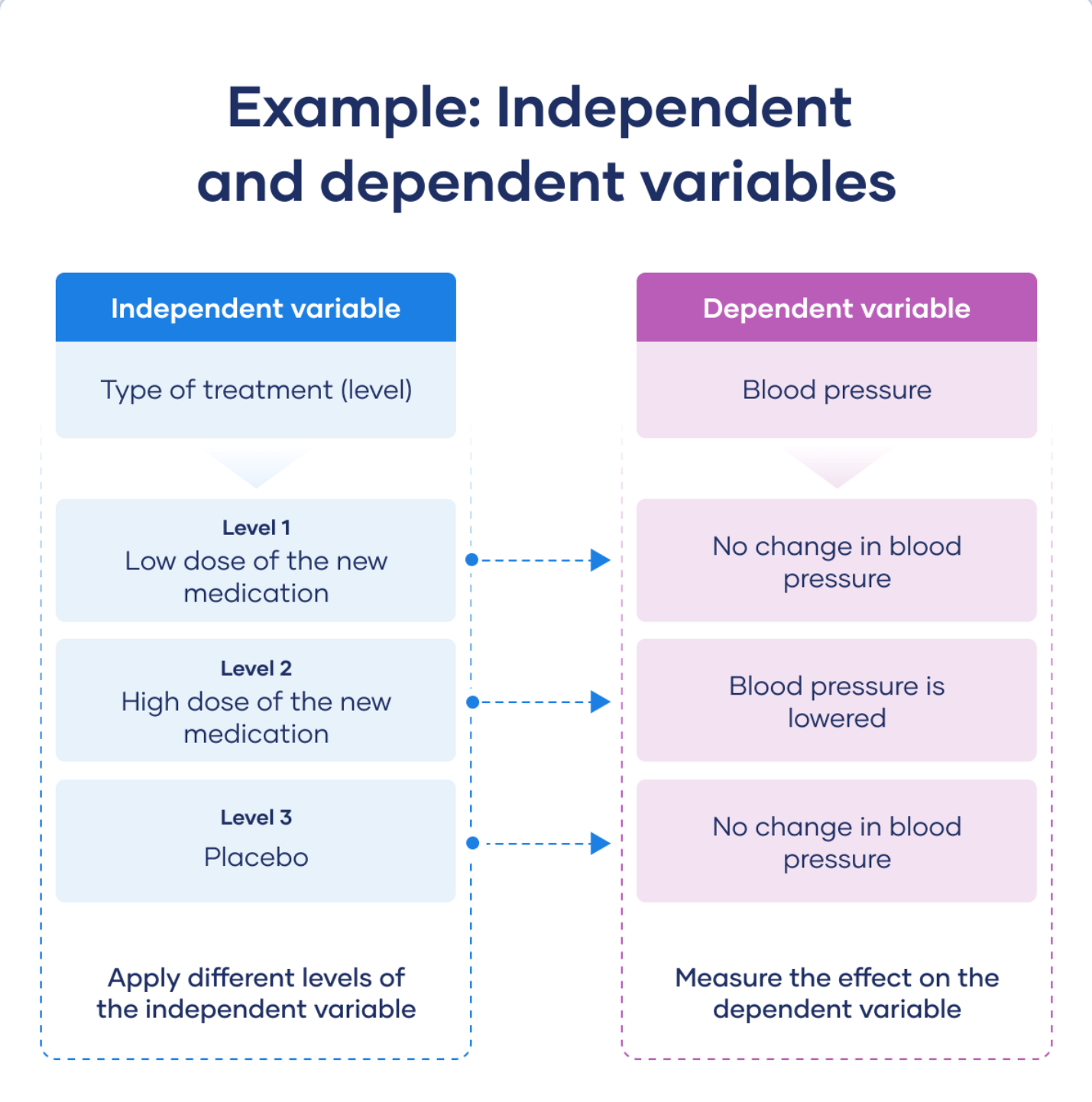
Name at least four common qualities shared by many model organisms.
-Cheap to raise
-Few ethical constraints
-Historical body of data
-Lots of variation
-Short life cycle
-small genome size
How big is the human genome? Approximately how many genes are there?
3.3 billion base pairs
21,000 genes
How big is the fruit fly genome?
180 Mb (million base pairs)
In the following abstracts, identify (when possible) the main research question, the hypothesis, independent variable, dependent variable, and conclusion:
O’Roak et al. 2011:
Evidence for the etiology of autism spectrum disorders (ASDs) has consistently pointed to a strong genetic component complicated by substantial locus heterogeneity1,2. We sequenced the exomes of 20 individuals with sporadic ASD (cases) and their parents, reasoning that these families would be enriched for de novo mutations of major effect. We identified 21 de novo mutations, 11 of which were protein altering. Protein-altering mutations were significantly enriched for changes at highly conserved residues. We identified potentially causative de novo events in 4 out of 20 probands, particularly among more severely affected individuals, in FOXP1, GRIN2B, SCN1A and LAMC3. In the FOXP1 mutation carrier, we also observed a rare inherited CNTNAP2 missense variant, and we provide functional support for a multi-hit model for disease risk3. Our results show that trio-based exome sequencing is a powerful approach for identifying new candidate genes for ASDs and suggest that de novo mutations may contribute substantially to the genetic etiology of ASDs.
Qiao et al. 2018:
It is a long-standing question as to which genes define the characteristic facial features among different ethnic groups. In this study, we use Uyghurs, an ancient admixed population to query the genetic bases why Europeans and Han Chinese look different. Facial traits were analyzed based on high-dense 3D facial images; numerous biometric spaces were examined for divergent facial features between European and Han Chinese, ranging from inter-landmark distances to dense shape geometrics. Genome-wide association studies (GWAS) were conducted on a discovery panel of Uyghurs. Six significant loci were identified, four of which, rs1868752, rs118078182, rs60159418 at or near UBASH3B, COL23A1, PCDH7 and rs17868256 were replicated in independent cohorts of Uyghurs or Southern Han Chinese. A prospective model was also developed to predict 3D faces based on top GWAS signals and tested in hypothetic forensic scenarios.
In O’Roak et al. 2011 the main question is what the major genetic component of ASDs is and to identify the part de novo mutations play.
Ind Var: de novo mutations dep var: genetic etiology of ASDs.
In Qiao et al. 2018 the main question is what genes define facial features in different ethnicities.
Ind Var: genetic bases dep var: facial features
Chromatid
One of the two identical halves of a duplicated chromosome; the two chromatids that make up a chromosome are referred to as sister chromatids.
Chromosome
Structures in the cell nucleus that are composed of chromatin and contain the genes. The chromosomes become visible under the microscope as distinct structures during cell division
Homologous chromosomes
Chromosomes that are similar in morphology and genetic constitution. In humans there are 23 pairs of homologous chromosomes; one member of each pair is inherited from the mother, and the other from the father.
karyotype
The chromosomal constitution of an individual. Representations of the karyotype are generally prepared by photographing the chromosomes and arranging the homologous pairs according to size, centromere position, and pattern of bands.
locus
the specific, fixed position on a chromosome where a particular gene is located (the actual location of the gene on a region of a chromosome)
diploid
The condition of having two sets of chromosomes per nucleus. Compare with haploid and polyploid
Haploid
The condition of having one set of chromosomes per nucleus. Compare with diploid and polyploid.
Somatic cell
are the cells in the body other than sperm and egg cells
Gamete
A sex cell; in plants and animals, an egg or sperm. In sexual reproduction, the union of gametes results in the formation of a zygote. The chromosome number of a gamete is designated n. Species that are not polyploid have haploid gametes and diploid zygotes
Autosome
a chromosome that is not a sex chromosome
Sex chromosome
a type of chromosome involved in sex determination
Dominant
a variant of a gene that expresses itself more strongly than other versions of the gene
Recessive
a gene that is less likely to be expressed in an individual
Homozygous
having inherited the same versions (alleles) of a genomic marker from each biological parent. Thus, an individual who is homozygous for a genomic marker has two identical versions of that marker.
Heterozygous
a genetic term that describes having two different versions of a gene, one inherited from each parent
Centromere
A specialized constricted region of a chromatid; contains the kinetochore. In cells at prophase and metaphase, sister chromatids are joined in the vicinity of their centromeres.
Synapsis
The process of physical association of homologous chromosomes during prophase I of meiosis
Crossing over/recombination
The breaking and rejoining of homologous (nonsister) chromatids during early meiotic prophase I that results in an exchange of genetic material
binary fission
a type of asexual reproduction where a cell splits into two identical daughter cells.
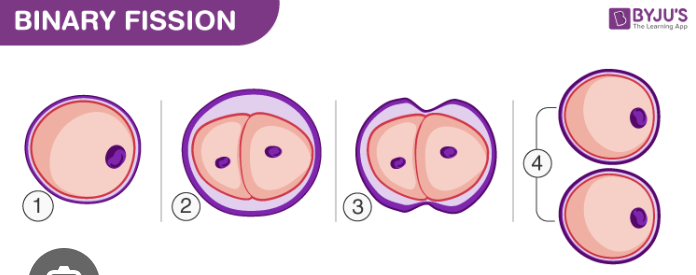
mitosis
The division of the cell nucleus resulting in two daughter nuclei, each with the same number of chromosomes as the parent nucleus; mitosis consists of four phases: prophase, metaphase, anaphase, and telophase. Cytokinesis usually overlaps the telophase stage.
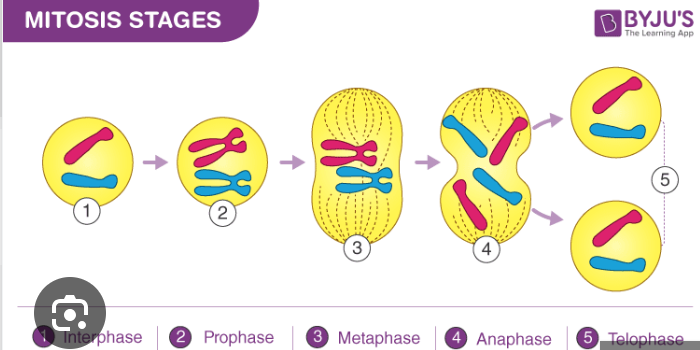
meiosis
Process in which a 2n cell undergoes two successive nuclear divisions (meiosis I and meiosis II), potentially producing four n nuclei; leads to the formation of gametes in animals and spores in plants.
What are three (or more) differences between the DNA inside of a typical bacterial cell versus the DNA inside of a typical eukaryotic cell?
DNA in prokaryotes is double-stranded and circular. Eukaryotic DNA, on the other hand, is double-stranded and linear. The amount of DNA in prokaryotic cells is significantly less than that in eukaryotic cells. The enzyme DNA polymerase replicates both prokaryotic and eukaryotic. No introns in DNA coding of bacterial cells but there are in eukaryotes.
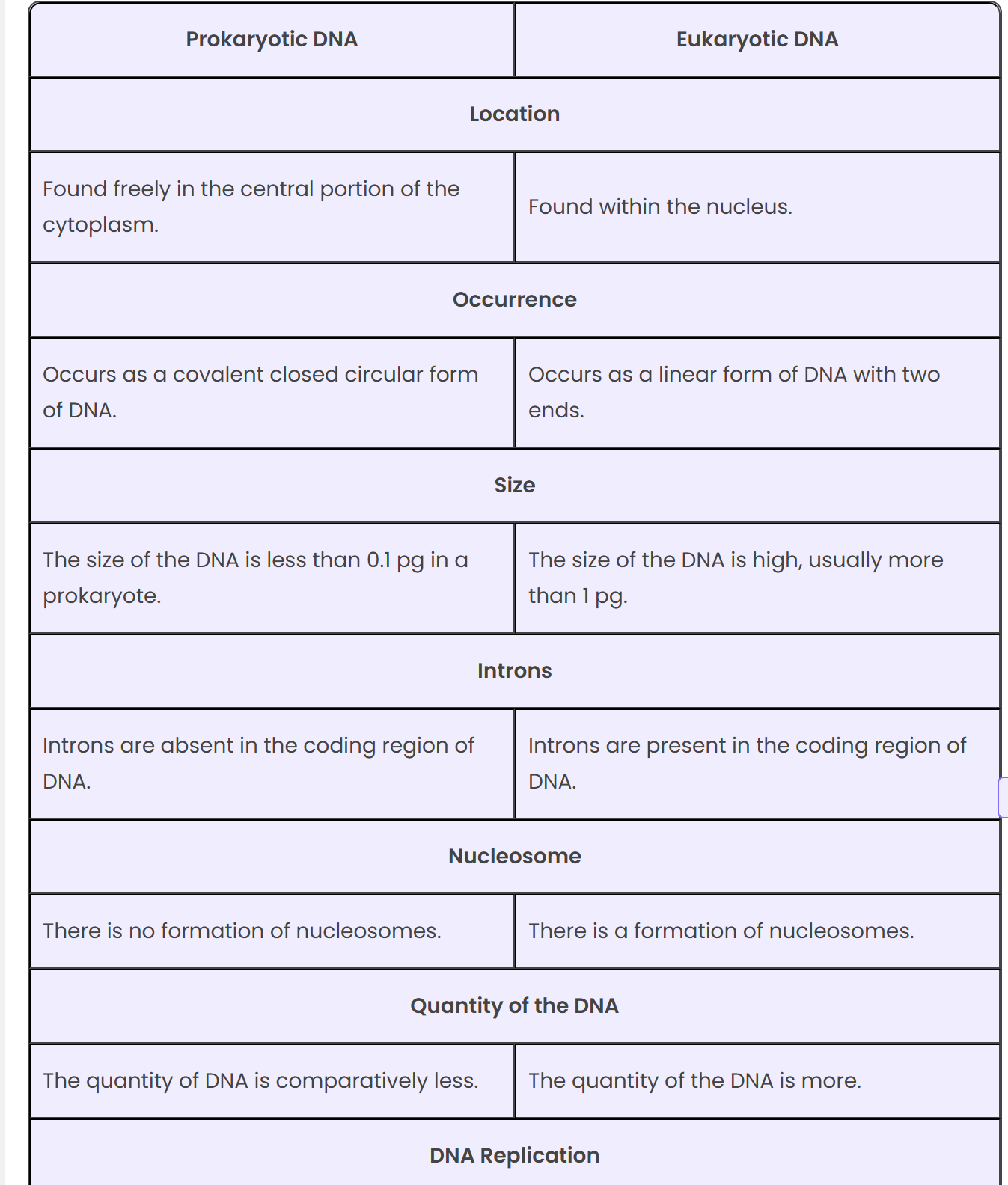
Draw schematic diagrams of the following cell types: 1N=10, 3N=6, 2N=4, 2N=8, 4N=8.
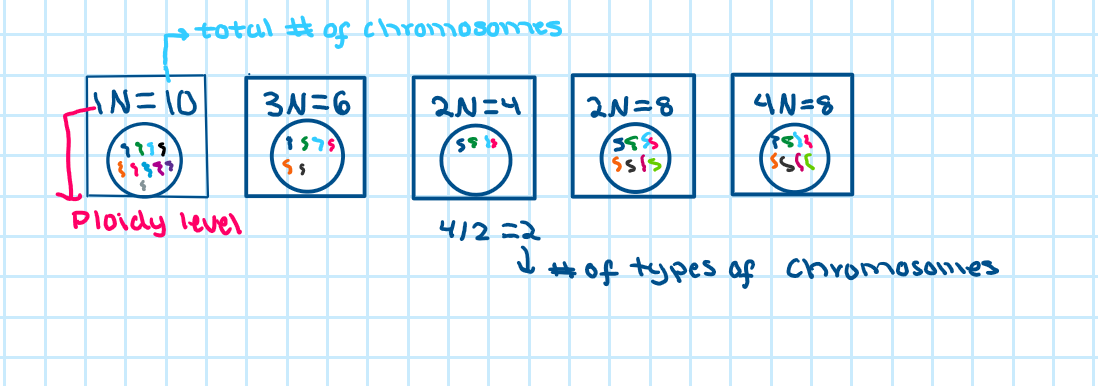
Diagram a pair of homologous chromosomes both immediately prior to metaphase of mitosis, and in telophase of mitosis, and identify the following where applicable: centromere, location of kinetochore proteins, sister chromatid.
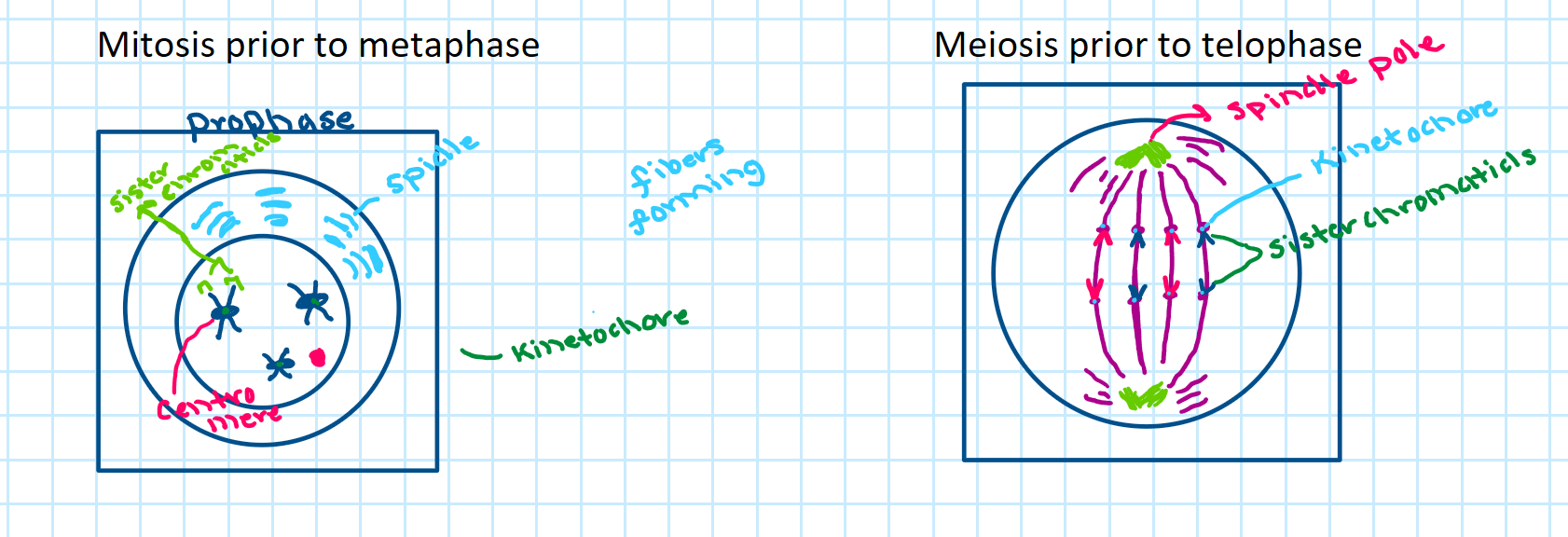
What is a sister chromatid? When does it technically come into existence?
one of two identical copies of a chromosome that are joined together at the centromere, formed during DNA replication in preparation for cell division
What makes homologous chromosomes homologous? In other words, what is homology?
Homologous chromosomes are considered homologous because they contain the same genes arranged in the same order, meaning they carry the same genetic information,
In a diploid cell, how many copies of each type of chromosome (autosome) are there? What about in a triploid cell? Pentaploid?
In a diploid cell, there are two copies of each type of autosome; in a triploid cell, there are three copies; and in a pentaploid cell, there are five copies of each type of autosome
Is the dominant or recessive allele expressed in each of the following genotypes, assuming complete dominance: homozygous dominant, heterozygous, homozygous recessive.
Complete dominance: dominant allele
homozygous dominant: The dominant allele is expressed
heterozygous: dominant allele
homozygous recessive: recessive allele
In humans, which chromosomes are the sex chromosomes and which are the autosomes?
In humans, the sex chromosomes are the X and Y chromosomes, while the autosomes are the first 22 pairs of chromosomes (numbered 1-22)
What is the term for bacterial cell division?
Binary fission
Diagram a diploid cell (2N=4) completing mitosis. On each chromosome place two genes, and assume each member of a homologous pair of chromosomes carries a different allele of the two genes that reside on it. Use letters to denote genes, and upper/lowercase to indicate alleles.
DO OR DELETE
Mendel’s first law of inheritance
"Law of Segregation," states that during gamete formation, the two alleles for a given trait separate from each other, meaning each gamete receives only one allele from the pair, ensuring that each offspring inherits one allele from each parent
Mendel’s second law of inheritance
Mendel's second law of inheritance, also known as the Law of Independent Assortment,states that different traits (genes) are inherited independently of each other during gamete formation. This means that the allele of one gene will sort into gametes independently of the alleles of another gene.
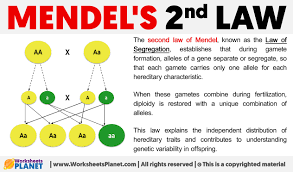
monohybrid cross
the hybrid of two individuals with homozygous genotypes which result in the opposite phenotype for a certain genetic trait.” “The cross between two monohybrid traits (TT and tt) is called a Monohybrid Cross.” Monohybrid cross is responsible for the inheritance of one gene.

Dihybrid cross
a breeding experiment between two organisms that are heterozygous for two traits. This means that each organism carries two different alleles for each trait.
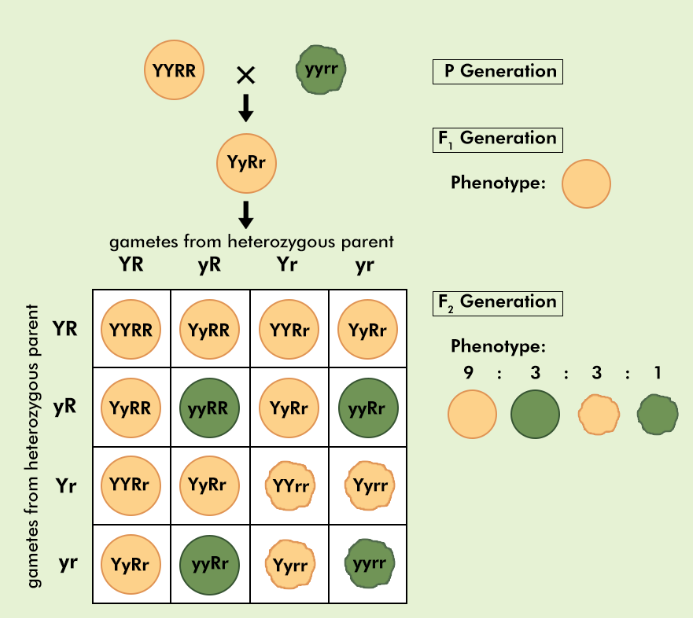
Test cross
a genetic experiment that determines an organism's genotype by crossing it with an organism that has a homozygous recessive genotype.
A testcross is a genetic cross used to determine the genotype of an organism exhibiting a dominant phenotype
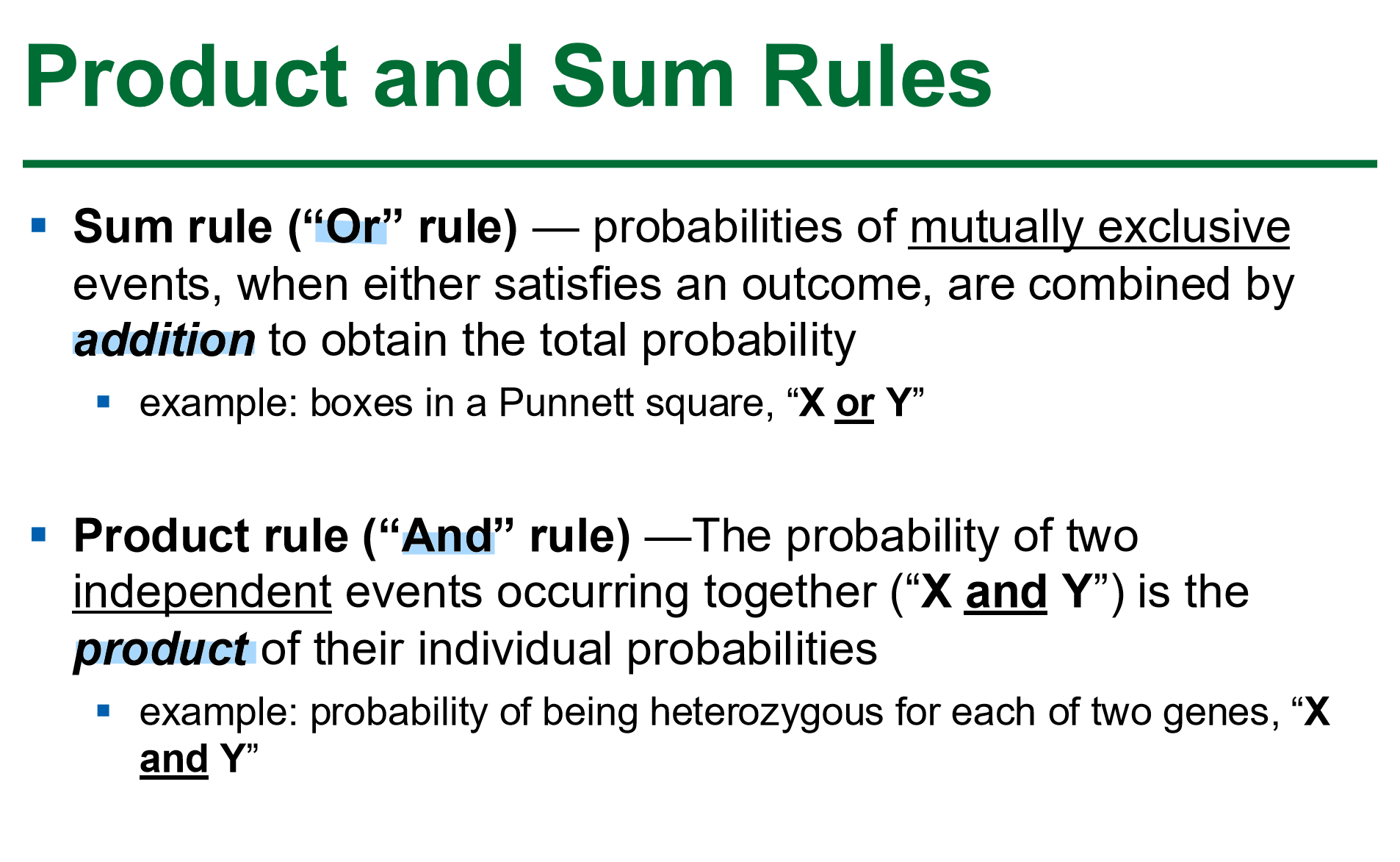
Sum rule
the probability of the occurrence of one event or the other, of two mutually-exclusive events, is the sum of their individual probabilities
(or)
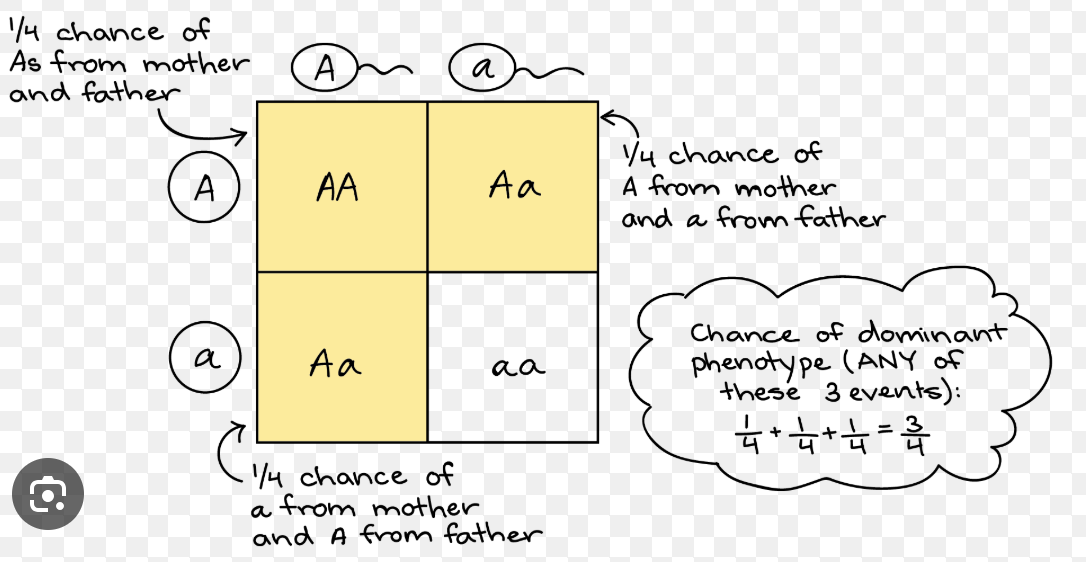
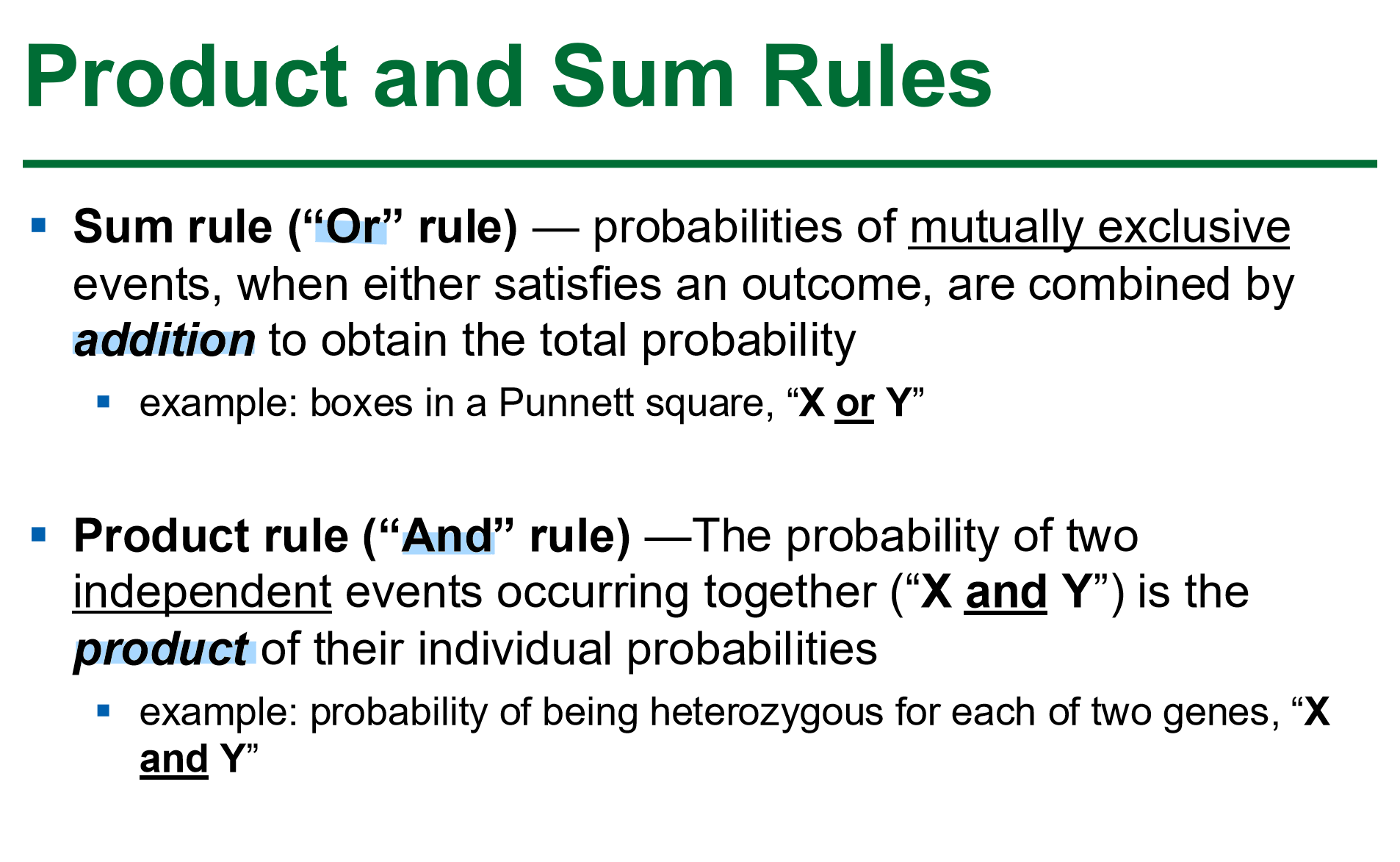
Product rule
the probability of two independent events occurring together can be calculated by multiplying the individual probabilities of each event occurring alone.
(And)
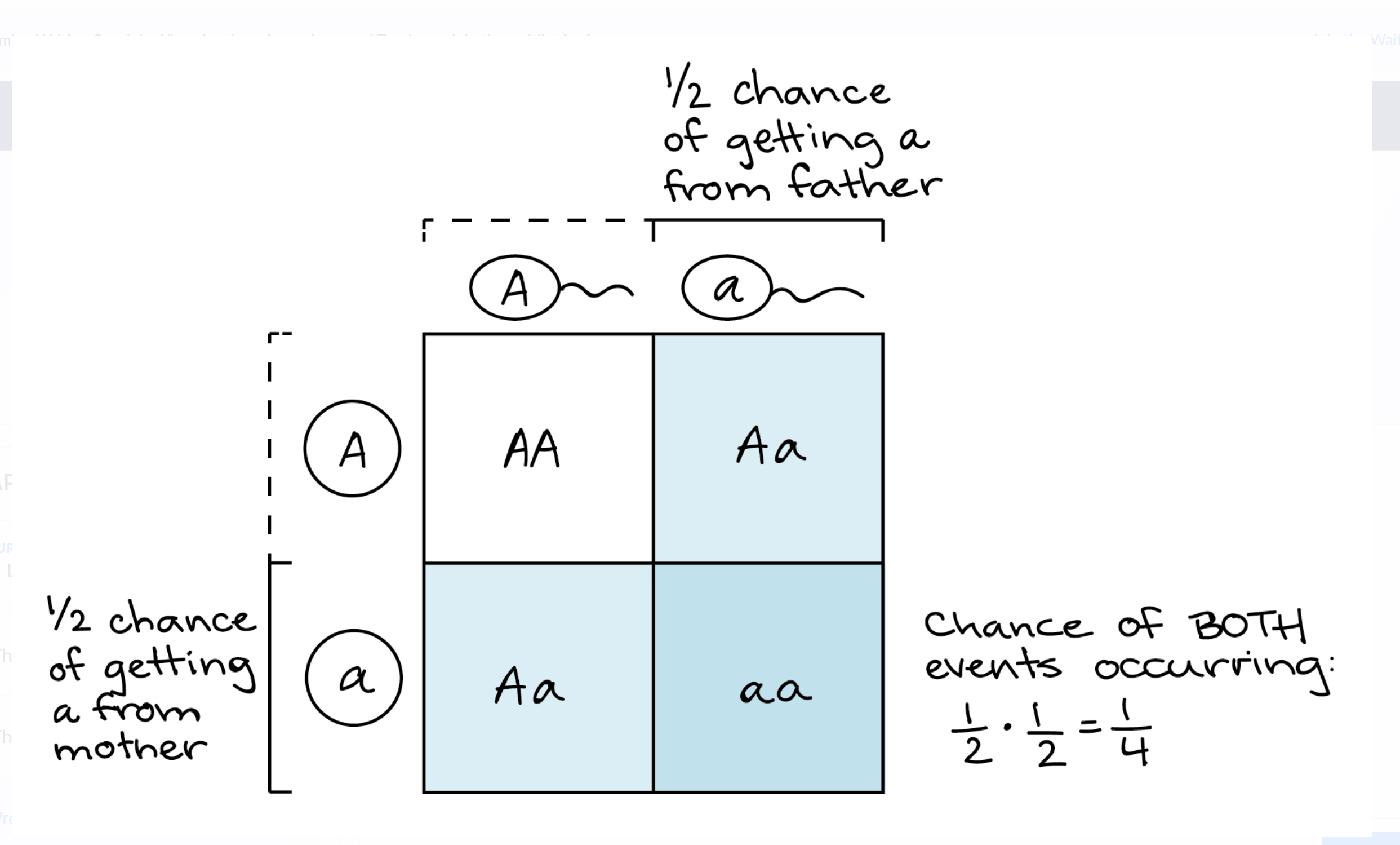
linkage
the close location of genes or other DNA markers to each other on chromosomes
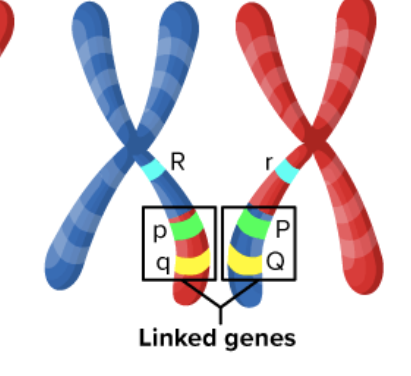
centimorgan
(cM) is a unit used to measure the distance between genes on a chromosome
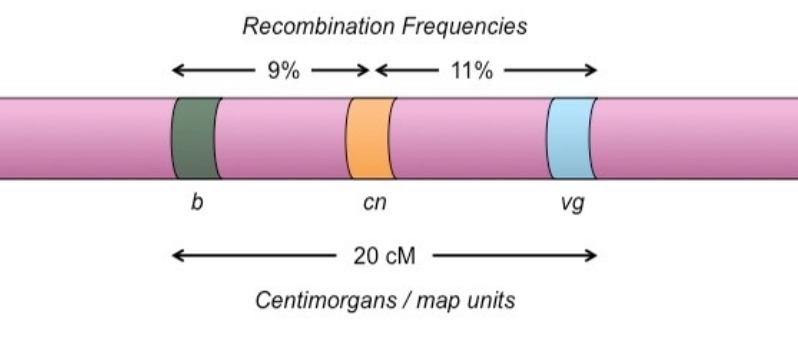
LOD analysis
a statistical technique used to determine if two genetic loci are close together on a chromosome and are likely to be inherited together. LOD stands for "logarithm of the odds"
*LOD scores > 3 = statistically significant support for linkage at a given recombination value (i.e., distance) LOD scores < -2 = statistically significant support for no linkage at a given recombination distance. LOD scores between -2 and +3 are inconclusive.
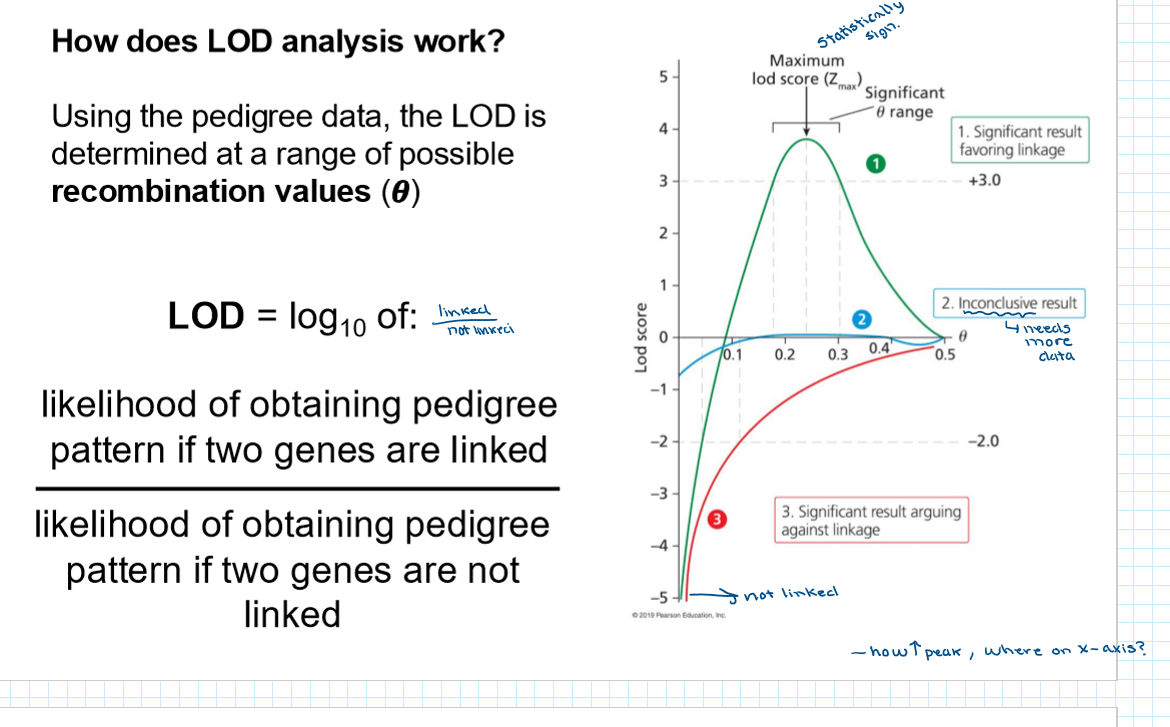
Pedigree
a method of studying how traits are passed down through a family by using a diagram called a pedigree chart. Pedigree charts are often used to trace the inheritance of diseases and abnormalities.

Punnett square
a diagram that predicts the possible genotypes and phenotypes of offspring from a cross between two individuals
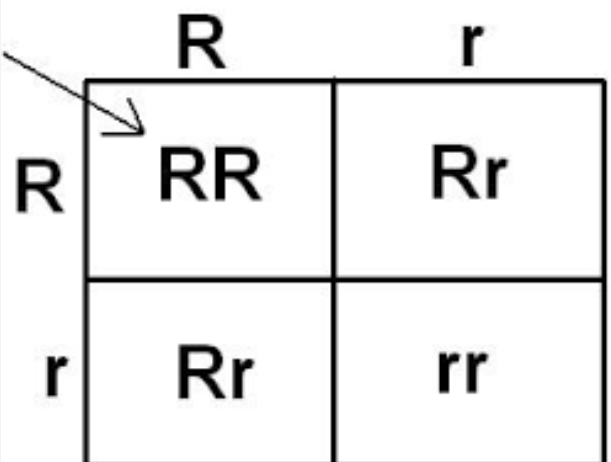
Describe, using a Punnett square, how Mendel’s Law of Segregation applies to gamete formation/meiosis in a pea flower heterozygous for flower color (Pp).
When a pea flower is heterozygous for flower color (Pp), Mendel's Law of Segregation states that during meiosis, the "P" allele and the "p" allele will separate from each other, resulting in each gamete (pollen or egg cell) receiving only one of these alleles, meaning half of the gametes will carry the "P" allele for purple color, and the other half will carry the "p" allele for white color, ensuring a 50% chance of inheriting either allele from the parent plant.
Describe, using a Punnett square, how Mendel’s Law of Independent Assortment applies to offspring ratios in a dihybrid cross of two pea plants, both of which are double heterozygotes for flower color and height (PpTt).
In a dihybrid cross between two pea plants that are both double heterozygotes for flower color (P - purple, p - white) and height (T - tall, t - short) (PpTt), Mendel's Law of Independent Assortment predicts that the offspring will exhibit a phenotypic ratio of 9:3:3:1, meaning 9/16 will be purple and tall, 3/16 will be purple and short, 3/16 will be white and tall, and 1/16 will be white and short; this ratio arises because the alleles for flower color and height segregate independently during gamete formation, resulting in all possible combinations of alleles being equally likely in the offspring
List all of the gametes that are possible from the following genotypes assuming independent assortment:
A. AaBbCc
B. aabbCc
For genotype AaBbCc, the possible gametes are: ABc, Abc, aBc, and abc.
For genotype aabbCc, the possible gametes are: aBC and abc.
A pea plant is purple-flowered, tall, yellow-seeded and has inflated pods. All of these traits are Mendelian, and the expressed phenotypes are all dominant. Describe two ways in which you could determine the genotype of this plant, and what the genotypic and phenotypic results would be if the plant was heterozygous at each locus.
Test cross
Self cross
Two pea plants are crossed. One parent has yellow and round seeds, with purple flowers. The other parent has green and wrinkled seeds, and also has purple flowers. The following offspring result from the cross:
300 yellow and round seeds, purple flowers
110 yellow and round seeds, white flowers
332 yellow and wrinkled seeds, purple flowers
106 yellow and wrinkled seeds, white flowers
335 green and round seeds, purple flowers
114 green and round seeds, white flowers
329 green and wrinkled seeds, purple flowers
102 green and wrinkled seeds, white flowers
Assuming simple Mendelian inheritance and using the above offspring counts, what can you say about the genotypes of the parent pea plants? Determine as many offspring genotypes as you can. Use Y and y for yellow and green seed color, R and r for round and wrinkled seed shape, and W and w for purple and white flower color.
Based on the given offspring ratios and assuming simple Mendelian inheritance, the parent pea plants are most likely both heterozygous for seed color (Yy) and seed shape (Rr), but homozygous dominant for flower color (Ww).
What is a testcross? Explain how Mendel used a testcross to determine the genotype of his F1 generation in a monohybrid cross.
A testcross is a specific type of genetic cross used to determine the genotype of an individual with a dominant phenotype. It involves mating the individual with an unknown genotype (that shows the dominant trait) with a homozygous recessive individual. Mendel used testcrosses to determine whether the F1 generation offspring in his monohybrid crosses were homozygous or heterozygous.
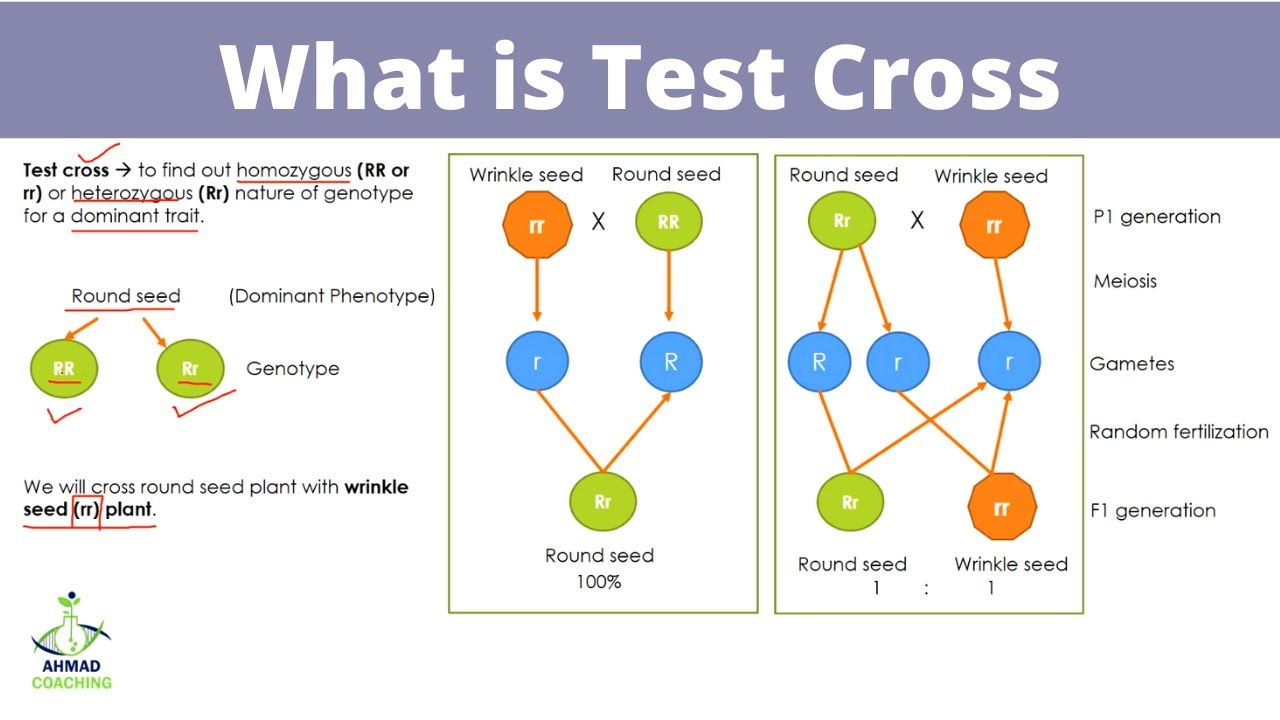
One hundred sets of parental flowering snapdragons are crossed. In each case, both parents have purple flowers (the dominant phenotype), but both are heterozygous for the flower color gene (Pp). Each cross results in five offspring.
What is the expected number of sets of offspring that will result in all white-flowered individuals?
What is the expected number of sets of offspring that will result in 4 purple and 1 white offspring, in any order?
What is the expected number of sets of offspring that will result in 2 purple and 3 white flowered offspring, in any order?
What are the odds of selecting a single seed from this cross that develops into a purple flowered plant, and then a second seed that develops into a white flowered plant?
All white offspring: Expect 0.0976 sets.
-100 * (1/1024) = 100 / 1024 = 0.0976.
4 purple, 1 white: Expect 39.57 sets.
-100 * (405/1024) = 40500/1024 = 39.57.
2 purple, 3 white: Expect 8.79 sets.
-100 * (90/1024) = 9000/1024
Purple, then white: Odds are 3/16.
-(3/4) * (1/4) = 3/16
(1/4)^5 = 1/1024
A pea plant heterozygous for alleles at the seed color and flower color genes (YyPp) is selfed and produces the following offspring:
150 yellow seeded, purple flowered offspring
40 yellow seeded, white flowered offspring
65 green seeded, purple flowered offspring
10 green seeded, white flowered offspring
Use the chi2 test to determine if these ratios are reflective of Mendelian inheritance.
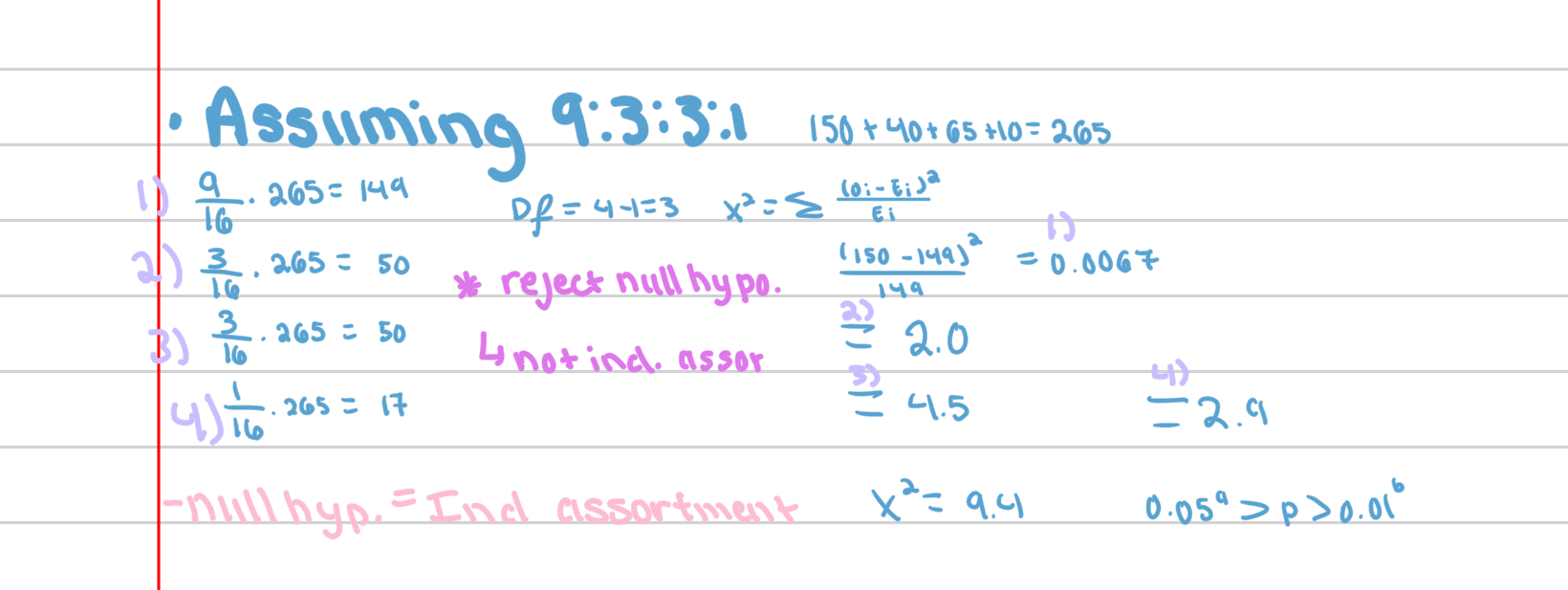
In the below LOD analysis, a potential disease-causing gene (D) was tested for linkage to several neutral genetic markers (PL1, PL2, PL3 and PL4).
Answer the following questions based on the LOD results shown in the chart above.
Which PL marker is most tightly linked to the disease-causing gene?
Which combination of markers is closer: PL1 and PL2, or PL3 and PL4?
What is the most likely recombination distance between the PL3 and PL4 markers?
PL2
PL3 and PL4 (because 10% recombination and PL1 and Pl2 15% recombination)
10%
XY sex determination
a system that uses sex chromosomes to determine an individual's biological sex. It's found in humans, most placental mammals, and some other animals and plants.

ZW sex determination
a chromosomal system that determines the sex of an offspring based on the sex chromosomes it inherits. In this system, females have two different chromosomes (𝑍𝑊),while males have two of the same chromosome (𝑍𝑍)
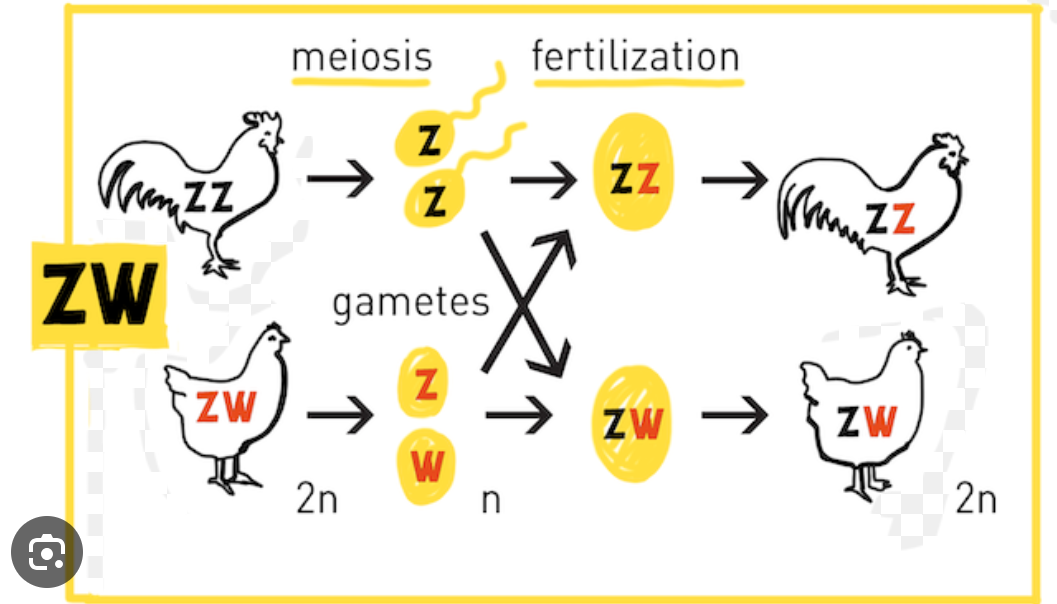
X/A ratio
the ratio of X chromosomes to autosomal sets in an organism
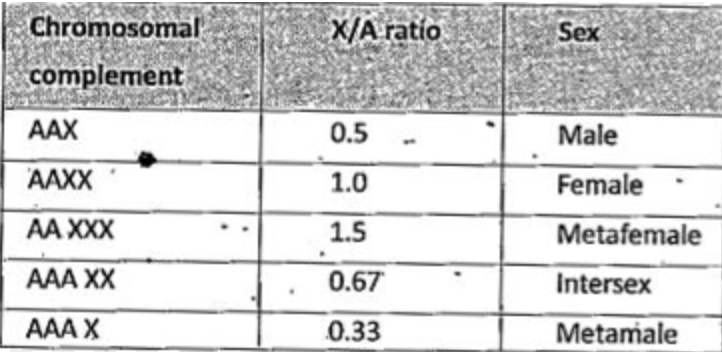
Temperature-dependent sex determination
a non-genetic process that determines the sex of some reptiles and fish based on the temperature of their eggs
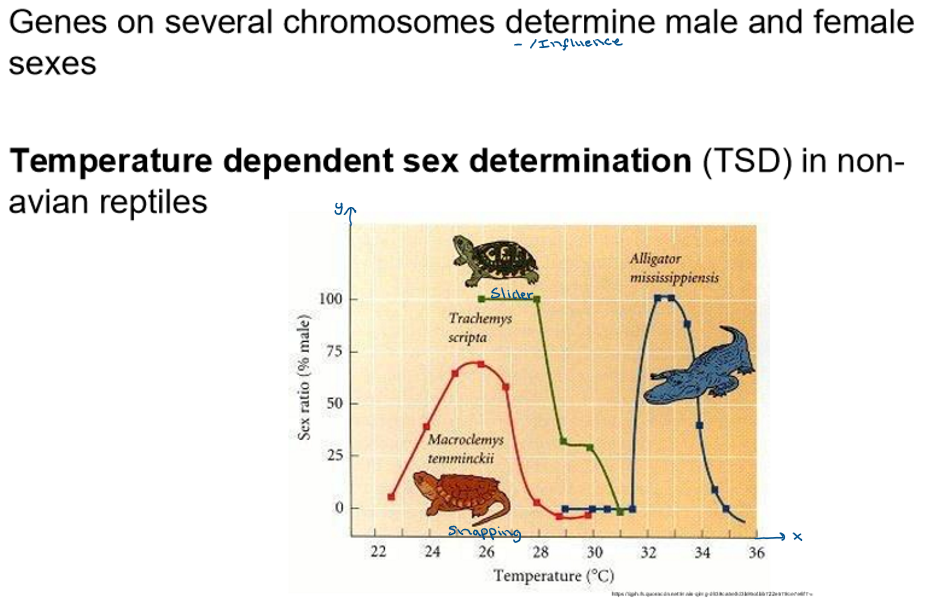
Barr body
a condensed, inactive X chromosome found in the nuclei of female cells
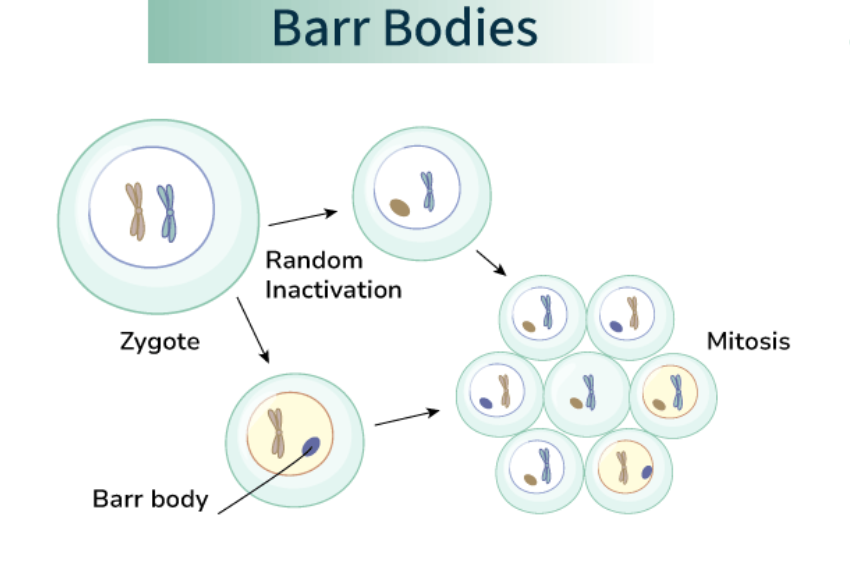
Dosage compensation
A mechanism by which species with sex chromosomes ensure that the homogametic sex does not have too much or the heterogametic sex too little activity of loci on the homogametic sex chromosome. The process, in organisms using a chromosomal sex determination mechanism (such as XX versus XY), that allows standard structural genes on the homogametic sex chromosome to be expressed at the same levels in females and males, regardless of the number of homogametic sex chromosomes. In mammals, dosage compensation operates by maintaining only a single active X chromosome in each cell (see Lyon hypothesis), while in Drosophila it operates by hyperactivating the single male X chromosome.
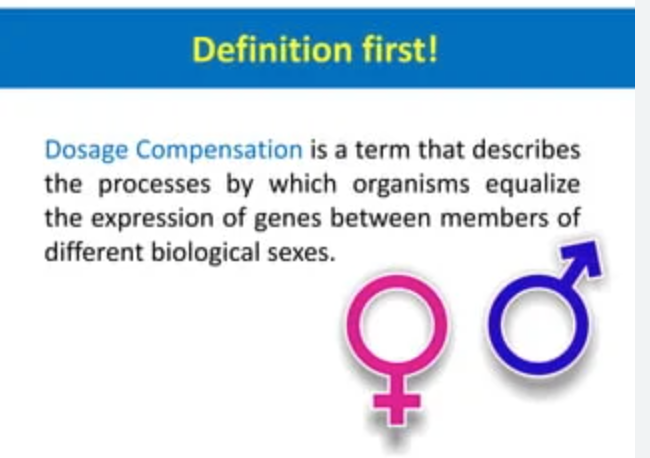
Sex-linked
a term used to describe traits that are only expressed in one sex. This can happen when genes are only expressed in one sex, or when different sets of genes are expressed in each sex.
Complete dominance
the effect of one allele in a heterozygous genotype completely masks the effect of the other
Incomplete dominance
a genetic phenomenon that occurs when neither allele of a gene is completely dominant over the other. This results in a phenotype that is a blend of the two alleles.
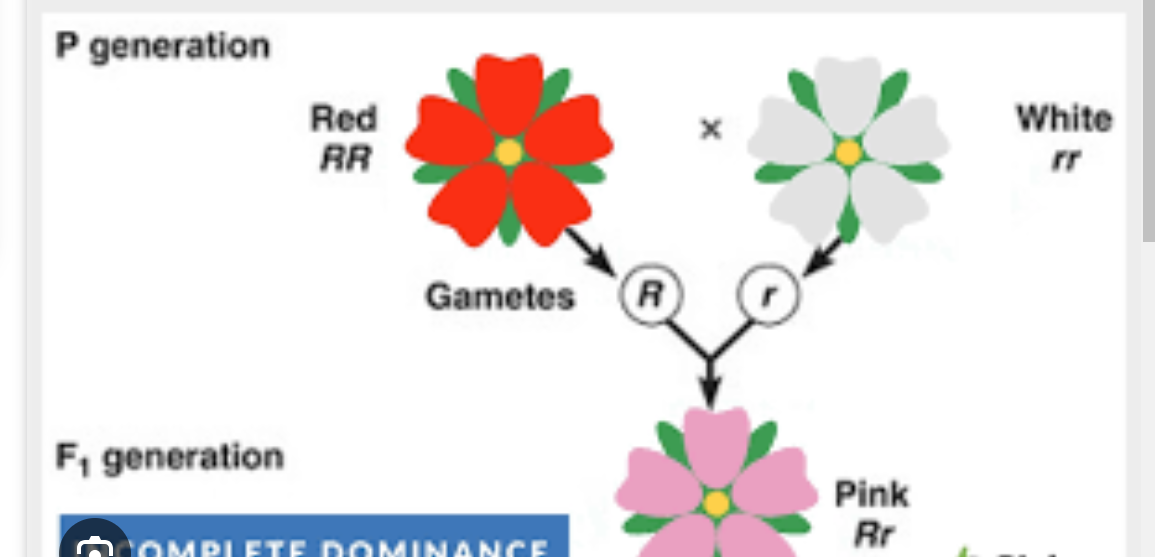
Overdominance
a genetic phenomenon where a heterozygote's phenotype is more pronounced than that of either homozygote.
*The heterozygote produced by two homozygote parents shows a phenotype that is more pronounced than that of the parents. Overdominance may also mean that the heterozygote has a higher fitness relative to the counterpart homozygotes. An example of this is a heterozygote for sickle cell anemia.
codominance
a type of inheritance where two different versions of a gene (alleles) are expressed equally, resulting in a combination of both traits.
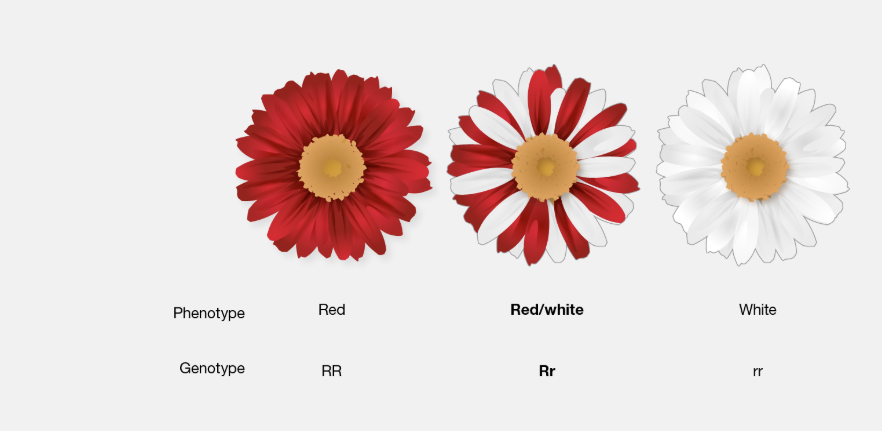
Penetrance
the likelihood that a clinical condition will occur when a particular genotype is present. For adult-onset diseases, penetrance is usually described by the individual carrier's age, sex, and organ site.
Epigenetic inheritance
the passing of epigenetic markers from one generation to the next. This process doesn't change the DNA sequence.
Pleiotropy
a genetic phenomenon where a single gene or DNA variant influences multiple traits in an organism.
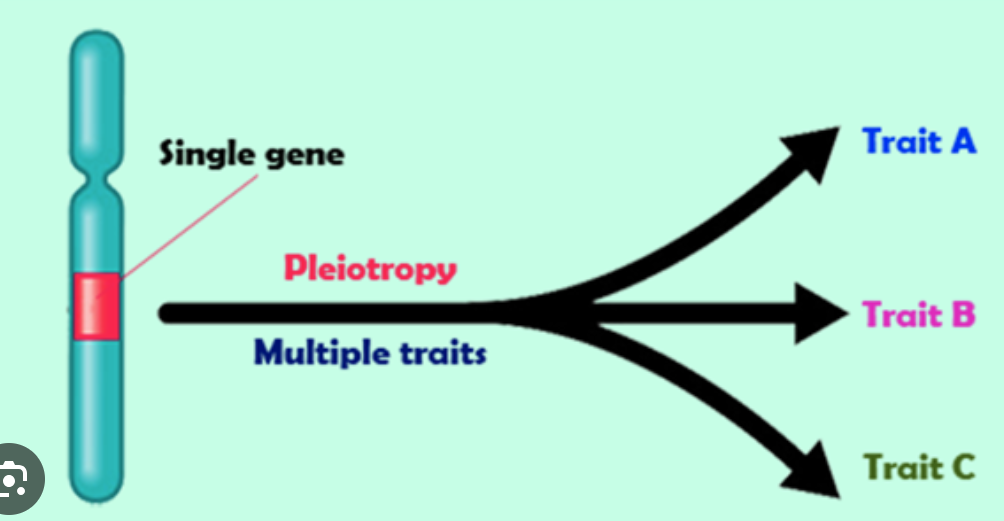
Epistasis
a circumstance where the expression of one gene is modified (e.g., masked, inhibited or suppressed) by the expression of one or more other genes.
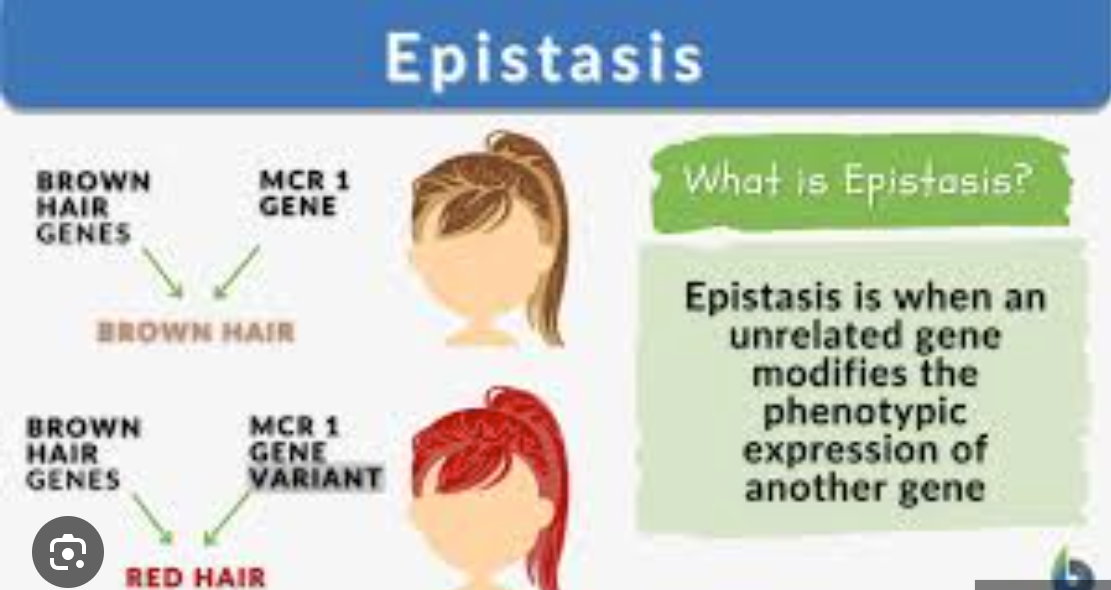
What are epistasis and pleiotropy? How do they differ?
Epistasis involves one gene affecting the expression of another gene, often at a different location on the chromosome. Pleiotropy, on the other hand, refers to a single gene influencing multiple phenotypic traits.
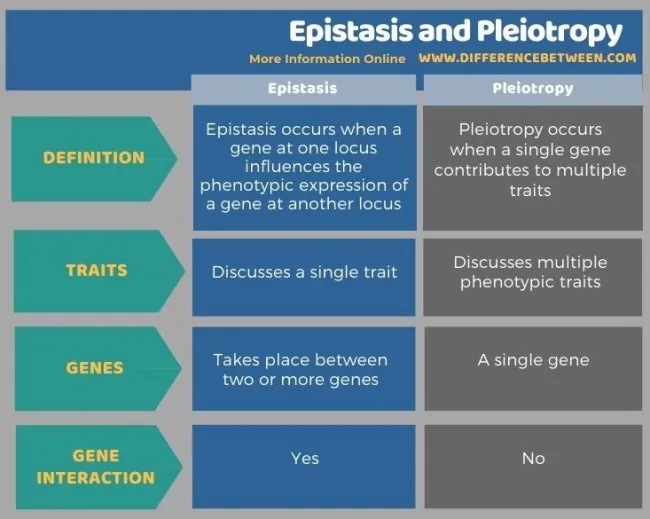
How is an individual with type AB blood an example of codominance?
An individual with type AB blood is an example of codominance because, at the molecular level, their red blood cells express both the A antigen and the B antigen equally, meaning both alleles (A and B) are fully expressed simultaneously, resulting in a distinct "AB" phenotype instead of an intermediate between A and B; this demonstrates that neither allele is dominant over the other, a key characteristic of codominance.
Two Siamese cats have the same genotype for coat color but one is nearly all white, while the other is nearly all dark. How might this occur, and what type of phenotypic expression is this?
Two Siamese cats with the same coat color genotype can display different coat colors (nearly all white vs. nearly all dark) due to variations in the expression of the white spotting gene. This difference in phenotypic expression is an example of variable expressivity, where the same genotype results in different phenotypes. This can also be influenced by the presence of modifier genes or environmental factors.
For the sickle cell gene (hb), individuals homozygous dominant (hbShbS) are susceptible to malaria, while individuals that are homozygous recessive (hbshbs) generally suffer from sickle-shaped red blood cells and associated complications. What is the condition of heterozygous (hbShbs) individuals, and how is this an example of overdominance?
In the sickle cell trait (heterozygous hbShbs), individuals have a normal hemoglobin and a sickle-cell hemoglobin, resulting in a condition where they are resistant to malaria, but do not suffer from the severe complications of sickle cell anemia. This is an example of overdominance because the heterozygous genotype has a greater fitness advantage than either homozygous genotype, providing protection against malaria.
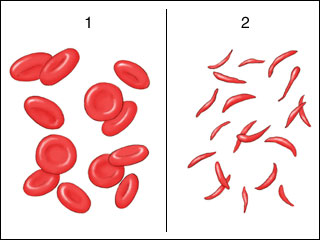
Assume single gene inheritance for plant height in sweet pea plants (from the ‘T’ gene). If the wild type allele of the height gene is only partially dominant to a recessive allele, what would you expect to see in the phenotype of an offspring resulting from a TT x tt cross?
In a sweet pea plant cross between a homozygous tall plant (TT) and a homozygous short plant (tt), the offspring will all be heterozygous (Tt) and exhibit an intermediate phenotype, meaning they will be tall but potentially shorter than the TT parent, depending on the degree of partial dominance.
MID-HEIGHT OFFSPRING
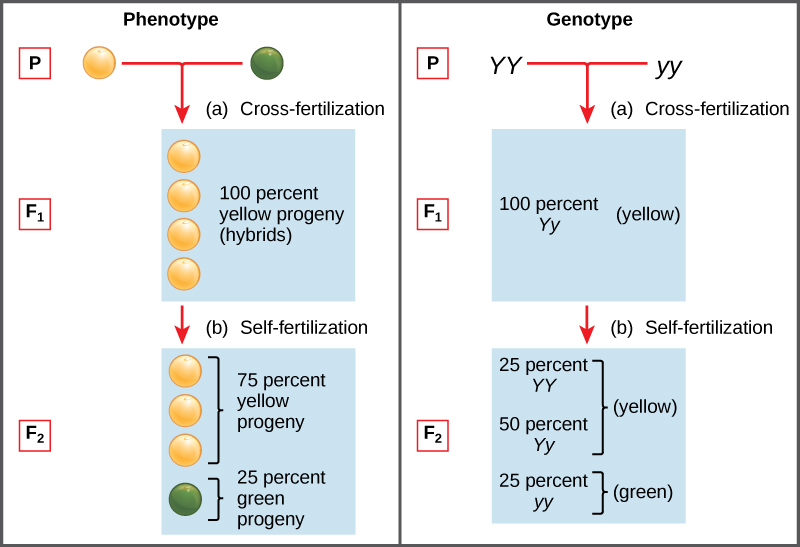
How can an individual Drosophila carrying a Y chromosome be a female phenotypically? How can an individual Drosophila carrying no Y chromosome still be a male?
In Drosophila, sex determination is primarily determined by the ratio of X chromosomes to autosomes, not by the presence or absence of the Y chromosome. An individual can be a female phenotypically with a Y chromosome if it has two X chromosomes (XXY), and a male without a Y chromosome if it has one X chromosome (XO)
How does co-dominance differ from incomplete dominance? Give an example of both.
In incomplete dominance, a heterozygous individual expresses a phenotype that is a blend of both parental traits. In codominance, both parental alleles are expressed simultaneously in the heterozygous individual, resulting in a phenotype where both traits are evident. For example, incomplete dominance is seen in snapdragons where a cross between a red and white flower produces pink flowers. Codominance is seen in blood types, where an individual with both A and B alleles expresses both A and B antigens
Give an example of environmental influence on phenotype.
A classic example of environmental influence on phenotype is the coat color of mice in snowy environments. Light-colored mice in snowy regions have a survival advantage because they blend in with the snow, making them harder to spot by predators. Conversely, in darker environments like volcanic soil, darker-colored mice would have the advantage due to better camouflage. This demonstrates how environmental selection pressure can drive changes in the population's phenotype over time.
Why is the O blood type called the ‘universal donor’? Explain from a genetic standpoint.
O blood type is called the "universal donor" because red blood cells with type O blood lack both A and B antigens, meaning they won't trigger an immune response when transfused into a person with any other blood type (A, B, or AB), as the recipient's body won't recognize these red blood cells as foreign; essentially, O blood has no antigens to be attacked by the recipient's antibodies, making it compatible with all blood types.
Quadripartite
four parted
Numt
genetic material mitochondrial to nuclear genome
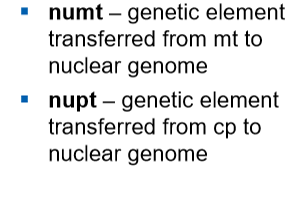
Nupt
Nuclear plastid DNA (NUPTs) are DNA fragments from plastids that have been integrated into the nucleus of a cell from the chloroplasts
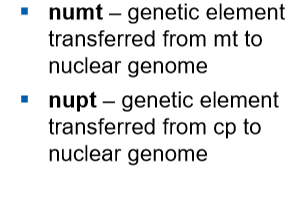
Endosymbiosis
the original internalization of prokaryotes by an ancestral eukaryotic cell, resulting in the formation of the mitochondria and chloroplasts.
Haploid
The condition of having one set of chromosomes per nucleus. Compare with diploid and polyploid.